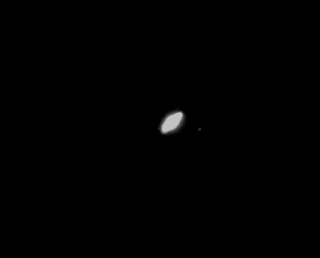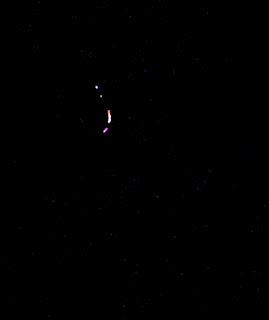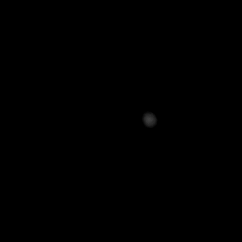August 29th 2200 GMT Meteor Hunt
August 29th 2100 GMT Jupiter and Saturn
August 29th 1015 GMT Sun
August 28th 2205 GMT Meteor Search
It had been a cloudy day and there was still quite a lot of
cloud around. I aimed the camera at Cepheus and hoped for a late Perseid
meteor.
At 2234 GMT, I caught a meteor in Cepheus but it was not a Perseid.
At 2345 GMT, I found am unidentified flying object below the cloud that looked a bit like the flying hockey stick I saw earlier in the year.
August 27th 1110 GMT Sun
Being the weekend, I was able to photograph the Sun with my
Mak, filter and DSLR at 1.54m focal length, ISO100 and 1/500 second exposure.
August 27th 0040 GMT Planets
My original intention was to capture Jupiter’s moons then
some deep sky targets but I noticed another opportunity. I started off with my
DSLR at 300mm focal length, ISO 6400 and 2 seconds exposure. I aimed at Jupiter
then decided to have a pot at Saturn’s Titan, even though they were getting low
in the sky.
Jupiter showed two moons.
I bagged Titan, too.
Instead of going for deep sky targets, I saw Mars near the
Pleaides. They were too far apart to capture at 300mm focal length, so I
reduced it to 70mm focal length and increased the exposure to 8 seconds. I stacked the best 75% of 17 light frames and 13 darks.
Fortunately, I also got Mars in the same field of view as
the Hyades star cluster. I stacked the best 75% of 12 frames and used the same darks.
August 27th 2310 GMT Meteor Search
I was hoping to start earlier but it was too cloudy. When it
cleared I aimed the camera between Cassiopeia and Perseus in the hope of
catching some late Perseids, even though it was just after the official end.
I caught a bright Perseid at 2355 GMT.
I stacked some images as by-products of meteor searches. The first image I took from the clipboard and is overexposed by shows Cassiopeia with the Andromeda Galaxy (M31) and Perseus Double Cluster.
The second image was a more conventional process. It does not show the Milky Way, Andromeda Galaxy and Perseus Double Cluster as well but shows Triangulum and Andromeda.
There were more similar shots before it got too cloudy.
August 26th 1730 GMT Sun
I snapped the Sun with my DSLR and filter at 300mm focal length, ISO 100 and 1/2000 second exposure.
August 26th 0500 GMT Venus
August 23rd 0655 GMT Sun
I snapped the Sun with my DSLR and filter at 300mm focal length, ISO 100 and 1/2000 second exposure.
August 20th 2230 GMT Meteor Hunt
August 20th 0735 GMT Sun and Moon
I snapped the Moon with my DSLR at 300mm focal length, ISO
400 and 1/200 second exposure.
I followed up with the Sun with a filter at 300mm focal length, ISO 100 and 1/2000 second exposure.
August 19th Jupiter’s Moons and Deep Sky
I aimed at Jupiter’s moons with my DSLR at 300mm focal length, ISO 6400 and 2 seconds exposure. I caught just one moon but a lot of background stars.
The close-up revealed that the "single moon" was two close together and that there were two "bumps" on the planet, which were the other two moons partly obscured.
I shot some widefield photos of Melotte 20 at 70mm focal
;length, ISO 6400 and 8 seconds exposure, followed by some darks.
Sometimes I get lucky shots and caught a Perseid meteor passing to the left (east) of the cluster.
This was the final result of the stack.
August 18th 1135 GMT Sun
I caught a single large sunspot but it needed a lot of processing to show.
August 15th 0715 GMT Moon
August 14th 1025 GMT Sun
August 14th 0425 GMT Moon and Planets
August 14th 2340 GMT Jupiter with Moons and Ours
August 13th 2125 GMT Meteor Hunt
August 13th 1145 GMT Sun
August 12th 2200 GMT Moon
August 11th 2050 GMT Moon
August 11th 0650 GMT Sun
I photographed the Sun using my DSLR at 300mm focal length, ISO 100 and 1/2000 second exposure. I did not detect any sunspots.
August 10th 2100 GMT Moon
August 10th 1615 GMT Sun
August 9th 2015 GMT Moon
August 9th 1120 GMT Sun
I snapped the Sun with my DSLR at 300mm focal length, ISO
100 and 1/2000 second exposure.
August 8th 2050 GMT Moon
August 7th 2015 GMT Moon
August 7th 1210 GMT Sun
Encouraged by the success of the day before, I did another white light shoot of the Sun, using the same settings.
August 7th 0110 GMT Jupiter’s Moons and Deep Sky
I was not finished for the night. I swapped my wide field
lens for my telephoto zoom lens and set it at 300mm focal length, ISO 6400 and
2 seconds exposure. I started with Jupiter.
I shot some darks then took quite a few frames of the
Pleiades (M45). It was at 0133 GMT, I caught my first visual Perseid meteor,
which was about as bright as Capella (Mag 0).
I ended up with a large number of frames of Melotte 20, hoping to better my shot from the previous month. I stacked the best 96 of 128.
August 7th 2300 GMT Meteor Hunt
August 6th 2150 GMT Meteor Hunt
I set up my camera with my usual meteor hunt settings. I aimed at Cassiopeia, as the sky was much clearer than the evening before. Naturally, I was hoping for some Perseid meteors, although it is not unusual to catch sporadic meteors in the same part of sky, when trying to catch shower meteors.
At 2232 GMT. I captured a short trail meteor very near the radiant. It is in the top left (north east) of the photo.
August 6th 2130 GMT Moon
August 6th 1025 GMT Sun
I took my Mak out to do some full disc solar shots. I used 1.54m focal length, ISO 100 and 1/500 second exposure. As I had a disappointing evening, this was a great comeback. I caught sunspots that were not on the Learmonth nor Big Bear images. I also caught faculae, a good pot in white light.
August 6th 2340 GMT Jupiter
I then tried the planet at 300mm focal length, ISO 100 and 1/100 second exposure.
Unfortunately, everything was out of focus.
August 5th 2210 GMT Meteor Hunt
August 5th 0535 GMT Sun
The sky was
clear but the Sun was low in the east. I bin scanned the Sun and found the
largest sunspot that I had seen on the Learmonth images.
August 4th 2010 GMT Moon
August 4th 0650 GMT Sun
August finally kicked off but not in a spectacular fashion. Some sunspots were visible in the Big Bear and Learmonth images but they did not show in my binoculars and filter. Conditions were hazy and the Sun was low but I would have expected to see at least the largest sunspot.














































































































